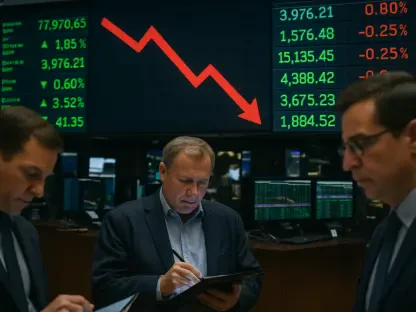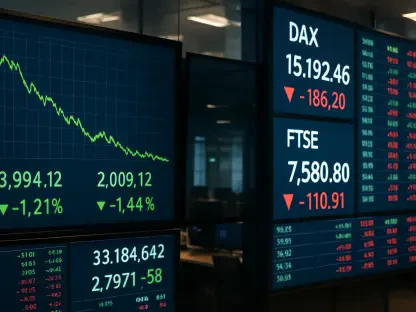The Chinese stock market, a vital indicator of one of the world’s largest economies, is currently experiencing a whirlwind of activity that captures both the promise and peril of corporate evolution. Recent post-market announcements from companies listed on the Shenzhen and Shanghai stock exchanges reveal a complex tapestry of innovation, regulatory scrutiny, and market volatility across sectors like technology, energy, pharmaceuticals, consumer goods, and real estate. These disclosures are far more than routine updates; they serve as critical signals of the broader economic direction in China, reflecting strategic maneuvers, unexpected challenges, and speculative fervor that shape investor sentiment. Every day, firms release updates on partnerships, equity shifts, legal hurdles, and operational changes, offering a real-time glimpse into a dynamic corporate landscape. This analysis aims to unpack the dominant trends emerging from these announcements, providing clarity on the forces driving growth and the risks tempering enthusiasm. From ambitious sustainability initiatives to sharp stock price swings fueled by market rumors, the current narrative is one of contrasting forces—proactive expansion set against cautious risk management. Understanding these patterns is essential for anyone monitoring global markets, as they highlight both the opportunities for investment and the uncertainties that demand careful navigation.
Corporate Growth Strategies
Strategic Partnerships and Collaborations
Recent corporate disclosures highlight a surge in strategic alliances, positioning companies to enhance their market presence and drive innovation in key areas. A notable example is Ronbay Technology’s partnership with CATL, where Ronbay has secured a role as the primary supplier of sodium-ion battery cathode powder, with CATL committing to procure at least 60% of its annual volume. This agreement underscores a broader industry shift toward sustainable energy solutions, aligning with global demands for low-carbon technologies. Such collaborations often aim to build ecosystems that address pressing challenges, positioning firms like Ronbay as pivotal players in the new energy sector. However, these partnerships are not without risks, as uncertainties in contract execution and market adoption can impact anticipated outcomes. Despite these challenges, the optimism surrounding such alliances suggests a strong belief in their potential to catalyze long-term growth and operational impact across competitive landscapes.
Another significant case is Samsung Medical’s subsidiary, Aoxin Smart Technology, which clinched a procurement contract worth approximately RMB 168 million with the State Grid Corporation of China. This deal exemplifies the growing importance of public-private collaborations in infrastructure development, particularly in sectors critical to national priorities. These partnerships often serve as a foundation for scaling operations and accessing new markets, reinforcing corporate stability through diversified revenue streams. Yet, the complexity of managing large-scale contracts with state entities introduces potential delays or policy-driven setbacks, requiring meticulous oversight. The trend of forming strategic alliances, as seen in these examples, reflects a calculated approach to leveraging external expertise and resources, even as firms remain vigilant about the inherent uncertainties that accompany such ambitious endeavors.
Equity Restructuring and Ownership Shifts
Equity changes and ownership restructurings are emerging as a prominent theme in recent announcements, signaling efforts to optimize corporate governance and attract strategic investment. Heshun Petroleum, for instance, disclosed plans by its actual controller and related parties to transfer 6% of the company’s shares to Chen Wanyi, with phased unlocking tied to performance commitments. This structured approach balances control dynamics with incentives for growth, illustrating a deliberate strategy to align ownership with long-term objectives. Such moves are often intended to inject fresh capital or expertise into the company, but they carry uncertainties regarding regulatory approvals and the fulfillment of performance targets. The fluidity of these equity shifts points to a market in transition, where companies are recalibrating their investor bases to support sustained financial health and strategic focus.
Similarly, Fudan Microelectronics revealed a significant transfer, with Guosheng Investment set to acquire a 12.99% stake, becoming the largest shareholder without altering control dynamics. This development suggests an increasing influence of state-backed entities in strategic sectors like technology, potentially stabilizing governance while raising questions about future autonomy. Other firms, such as B-Soft Technology, are engaged in negotiations for control rights changes, while Qianli Technology plans a stake reduction by a major shareholder. These cases highlight a broader trend of ownership realignment aimed at enhancing competitiveness, though the final outcomes remain subject to regulatory scrutiny and market conditions. The cautious optimism surrounding these restructurings reflects a recognition of their potential benefits, tempered by the complexities of navigating a shifting corporate landscape.
Market Dynamics and Risks
Abnormal Stock Price Movements and Speculation
Market volatility, driven by speculative trading, has become a recurring concern in recent corporate announcements, with several companies addressing abnormal stock price movements. Joyoung Co., Ltd., for example, experienced two consecutive trading limit-ups and issued a clarification distancing itself from unrelated business concepts like the food and beverage sector, reaffirming its focus on small home appliances. This response underscores the challenge of managing investor expectations when price surges are fueled by rumors rather than fundamentals. Such fluctuations can distort market perceptions, prompting firms to issue public statements to curb irrational enthusiasm and highlight inherent trading risks. The prevalence of these scenarios reveals a market environment susceptible to hype, where short-term noise often overshadows long-term value, creating a pressing need for transparent communication to maintain stability.
Furun Shares, another company facing volatility with seven consecutive daily limits, similarly cautioned against irrational speculation, noting the absence of expansion plans for its new energy division. This pattern of sharp price swings, also seen in firms like Z众生Pharmaceutical and Z真爱美Home, points to a broader issue of speculative behavior driving valuations beyond sustainable levels. Companies are increasingly vocal about the risks associated with such trends, urging investors to focus on operational realities rather than market gossip. These warnings reflect a shared concern over the potential for speculative bubbles to undermine confidence, emphasizing the importance of grounding investment decisions in concrete data. As volatility persists, the market’s ability to differentiate between genuine growth signals and temporary fervor remains a critical challenge for stakeholders.
Regulatory and Legal Challenges
Regulatory and legal hurdles are casting significant shadows over some companies, as heightened oversight reshapes corporate behavior in China’s stock market. Maihe Shares, for instance, announced that its controlling shareholder and chairman, Wang Jinping, is under investigation and detention, with temporary leadership arrangements put in place to ensure operational continuity. Such developments can disrupt strategic planning and erode investor trust, highlighting the profound impact of regulatory scrutiny on corporate stability. The need to adapt swiftly to these challenges, often through interim management or public reassurances, becomes paramount for maintaining business momentum. This case exemplifies a broader trend of authorities enforcing stricter compliance, pushing firms to prioritize transparency even under duress.
In another instance, Haoersai Technology Group faces uncertainty due to a procuratorate protest against a lenient first-instance verdict on unit bribery charges, complicating the legal outlook for the firm. Meanwhile, China Fortune Land Development’s acceptance of a pre-reorganization application by a court signals financial distress but also a potential pathway to recovery through restructuring. These legal and regulatory challenges reflect a tightening of oversight aimed at fostering accountability, often at the cost of short-term operational setbacks. Companies navigating these issues must balance immediate crisis management with long-term strategies to rebuild confidence. The increasing frequency of such cases suggests that regulatory pressures will continue to influence market dynamics, compelling firms to align more closely with compliance standards to mitigate risks.
Innovation and Sectoral Insights
Innovation as a Competitive Driver
Innovation stands as a cornerstone of corporate strategy in China’s stock market, particularly in high-growth sectors like technology and pharmaceuticals, where companies are investing heavily to secure competitive edges. Zelgen Pharma’s receipt of FDA orphan drug designation for ZG006 Injection, targeting neuroendocrine cancer treatment, marks a significant milestone in its global ambitions. This achievement highlights the potential for Chinese firms to penetrate international markets through cutting-edge research, despite the uncertainties surrounding clinical trial outcomes and regulatory approvals. The pursuit of such designations reflects a broader commitment to addressing unmet medical needs, positioning innovation as a key driver of future growth. However, the long timelines and high costs associated with bringing new treatments to market remain formidable barriers that require sustained focus and resources.
Heshun Petroleum’s planned cross-border acquisition of control in Kuixin Technology, a firm specializing in integrated circuit IP and chiplet product development, further illustrates the drive for innovation beyond traditional sectors. This strategic pivot into high-tech areas amidst conventional energy operations signals an intent to diversify and capture emerging opportunities in digital transformation. Similarly, Z众生Pharmaceutical’s advancement of multiple Phase III clinical trials for innovative drugs underscores the emphasis on research and development to stay ahead in a competitive landscape. These efforts, while promising, are accompanied by inherent risks, including regulatory hurdles and market acceptance challenges. The trend of prioritizing innovation across industries demonstrates a forward-looking mindset, with firms betting on long-term gains even as they navigate the complexities of development and implementation.
Sector-Specific Developments
The Chinese stock market reveals a diverse array of sector-specific trends, each shaped by unique pressures and opportunities as evidenced in recent announcements. In the energy sector, Ronbay Technology’s focus on sodium-ion battery production through its partnership with CATL positions it at the forefront of sustainable technology, aligning with global green energy priorities. Conversely, Heshun Petroleum’s diversification into integrated circuits via acquisition reflects a strategic shift beyond traditional oil operations, while Furun Shares tempers expectations by clarifying limited expansion in new energy. These varied approaches within the energy sector highlight a dual focus on innovation and caution, as companies balance ambitious goals with market realities. The interplay of sustainability drives and operational constraints shapes distinct corporate paths, influencing investor perceptions and sector growth trajectories.
In consumer goods, firms like Joyoung Co., Ltd. and Z真爱美Home are grappling with speculative trading pressures, sticking to core operations amid market noise around unrelated business concepts or asset restructuring plans. Meanwhile, the technology sector faces a mix of progress and pitfalls, with Fudan Microelectronics navigating ownership changes and Maihe Shares dealing with legal scrutiny over leadership issues. The pharmaceutical industry, exemplified by Zelgen Pharma and Z众生Pharmaceutical, is driven by innovation but tempered by clinical uncertainties, while real estate firms like China Fortune Land Development confront financial distress through restructuring. Cross-sectoral dynamics, such as Samsung Medical’s infrastructure contracts and B-Soft Technology’s control rights negotiations, further enrich the landscape. This intricate web of industry-specific developments underscores the multifaceted nature of China’s corporate environment, where tailored strategies are essential to address distinct challenges and capitalize on emerging prospects.
Reflecting on Market Shifts
Looking back, the wave of post-market announcements from Chinese companies listed on the Shenzhen and Shanghai exchanges painted a vivid picture of a corporate landscape marked by ambition and adversity. Strategic partnerships and equity restructurings showcased a determined push for growth and stability, while abnormal stock price movements and regulatory challenges reminded stakeholders of the inherent volatility and scrutiny defining the market. Innovation, particularly in technology and pharmaceuticals, emerged as a beacon of progress, even as sector-specific struggles revealed the uneven terrain firms had to navigate. For those tracking these developments, the next steps involve closely monitoring how companies execute on their strategic alliances and innovation pipelines, ensuring they mitigate execution risks through robust planning. Investors should prioritize fundamentals over speculative noise, seeking out firms with transparent communication to weather market fluctuations. Additionally, staying informed on regulatory shifts will be crucial, as compliance remains a pivotal factor in sustaining corporate trust. As the market continues to evolve, focusing on adaptability and due diligence will help stakeholders harness opportunities while addressing the complexities that unfolded in this dynamic period.









